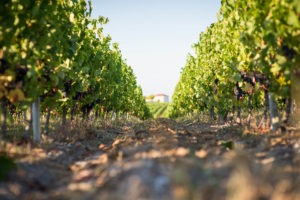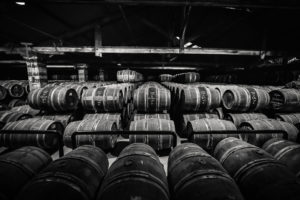We all have a story about tequila… A boozy night… Laughs and friends… Small lights… A summer and a bar… Music and the sticky floor because of the alcohol… Drinks all around… Tiny glasses full of a translucent liquid… A lime and salt on the hand… And paf ! Drink down this little glass ! Alcohol flows and burns the oesophagus, the teeth tense up and everybody is doing a little rictus while creases the eyes ! It wasn’t the first round and it won’t be the last… The morning after will be difficult ! It’s at the moment that the second paf arrives : it’s like you got a punch of Rocky Balboa ! I’m not a big fan of this spirit (it’s like I repeat myself… like with the saké) but after this tasting at Vinexpo organized by the Tequila Regulation Council, I changed my mind (again) ! I haven’t finished with a sombrero on my head, screaming Ariba Ariba, but my heart beat wildly the Mariachis tunes !
“As soon as I saw this lightly and proud morning wake up and shine on the New-Mexico deserts, something shut down in my soul and listen to…”
Tequila is synonymous of Mexico! We have to admit that Tequila comes from this region of Central America. Tequila is created with an only one plant: Blue Agave. It exists two types of Tequila: one produced with 100% Blue Agave and one produced with minimum 49% of Blue Agave and 51% of other natural sugar. Tequila is a spirit linked with Mexican mythology. Back in the time, the Plumed Serpent felt in love with a beautiful young lady named Mayâhuel. But her Grandmother was a demon and to protect her granddaughter, she killed her (yes, it’s a weird way to protect someone). The Plumed Serpent, devastated, took the body of her love and buried it. Where the grave was, a plant has grown: it’s the Agave. Its thorns leaves turned to the sun allow the plant to protect itself and it will give joy to men thanks to the alcohol it offers. Cooked Agave gives a sweet juice, its fermentation allows to men to talk with Gods. Then Tequila was a beverage for Kings.
In order to produce Tequila, Blue Agave is cultivated in fields. You have to wait between 7 to 10 years to get a mature plant. Finally, when it’s ready to be ‘harvested’, the ‘Jima’ process will begin: it’s the process to take off the leaves in order to keep the heart of Agave. It looks like a huge pineapple named Piña ! It weights between 30 to 60 kg! Then, Agave is cooked and the juice will be extracted. Back in the time, ‘Tahona’ was used to press the plants: they were put in a big terra-cotta circle and a wooden wheel was running over to take out the juice. Water is added in order to begin the fermentation in vats. Some sugar can also be added. Tequila knows two distillations and is finally put in barrels (French or American) or in bottle directly. It’s here that you have to know the different denominations of Tequila. If the Tequila is directly put in bottle, it’s a Silver or Blanco Tequila. But, if the Tequila has been put in barrels for two months, it’s a Reposado. If the Tequila stayed one year minimum in barrels, it’s a Añejo Tequila. And at last, if it stayed three years minimum in barrels, it’s an Extra Añejo Tequila and its color is gold.
The Tequila tasting looks like the wine one. We are looking at the color first and also the tears. Then we are doing the bottom nose (we are putting the nose on the bottom of the glass) and the high nose (you have to put the bridge of the nose on the superior edge of the glass). It’s not necessary to do an aeration: the two noses are efficient enough. The bottom nose will be powerful with flavors and alcohol. The high nose will be more delicate. For the tasting, you have to take a little bit of Tequila in the mouth and you have to do like a mouthwash (it’s so sexy). Finally you spit or you swallow ! Don’t forget that alcohol is dangerous for health, so drink carefully especially if you drive afterwards. Tequila is not like whisky: you don’t add water to exalt the flavors. So let’s see now the different types of Tequilas I’ve tasted during this master class : they contain between 35% and 55% of alcohol.
– Silver Tequila, 100% Blue Agave
Translucent color like water with silver reflects: we can’t get it wrong, it’s a Silver Tequila with nice speed tears. The bottom nose is heavy on alcohol but soft. Fresh on lemon, anise and liquorice, the high nose is less powerful but confirms the aromas. The mouth is spicy on the tong, sweet, smooth and nice ! I find liquorice but also pepper and mint. It’s good! But not straight!!
– Reposado Tequila, 100% Blue Agave
It’s a nice gold in the glass with slow tears falling. The bottom nose reminds me vanilla and coconut. The nose seems to be softer than the Silver but with the same alcohol level. The high nose has got clay notes (thanks to beauty masks !!) mixed to woody flavors. The mouth is sweet, nice on honey and wood. Nice Tequila!
– Añejo Tequila, 100% Blue Agave
The color is deep amber yellow with bronze reflects. Tears are falling slowly and the bottom nose is on coconut. Alcohol is less strong and the whole Tequila is lighter. More complex, the high nose reminds clay (again) and coffee. Caramel appears with chestnut! The mouth is powerful, sweet with vanilla flavors but also coconut, wood, anis seed, cinnamon and honey. The finish is very fresh, very nice on pine, pine cone and ever Christmas tree!!
Little surprise at the end of this tasting: I tasted Mezcal! Tequila is a type of Mezcal but every Mescals are not Tequilas. I explain… Mezcal is created with Agave. But not 100% of Blue Agave. In fact you can find 15 different kinds of Agave in this alcohol which is produced by 8 states of Mexico. In order to differentiate Mezcal to Tequila, we can find a little larva in the bottle ! This larva is named Hypopta Agavis (or Chilocuil) and it eats the Agave’s leaves. It’s also not rare to find a scorpion… But it’s marketing… You can find Silver, Reposado or Añejo Mezcal. The alcohol level of Mezcal is around 38% to 55%.
– Silver Mezcal
Limpid like water, the bottom nose is quite earthy, smoky and maybe a little bit animal. The high nose adds a woody note. Mezcal is really different of Tequila and it’s uncommon but nice. The mouth is strong, powerful, smoky like a cooked ham and earthy.
– Reposado Mezcal
In the glass, the gold is discrete. The bottom nose is powerful but nice with pepper, honey and orange notes which are confirmed by the high nose. The mouth is smoky, spicy on vanilla and pepper. The whole Mezcal is fresh and unique.
I’m a little bit sorry of this tasting… I’m really happy about it because I had a really bad memory of Tequila ! No one of these spirits has to be drank straight or with Sangria ! What a shame!! But I’m sorry because I don’t know the names of the Tequilas and Mezcals I’ve tasted! So I can’t make any advis ! The only one solution: to do a tasting… again! It’s a good apology !



